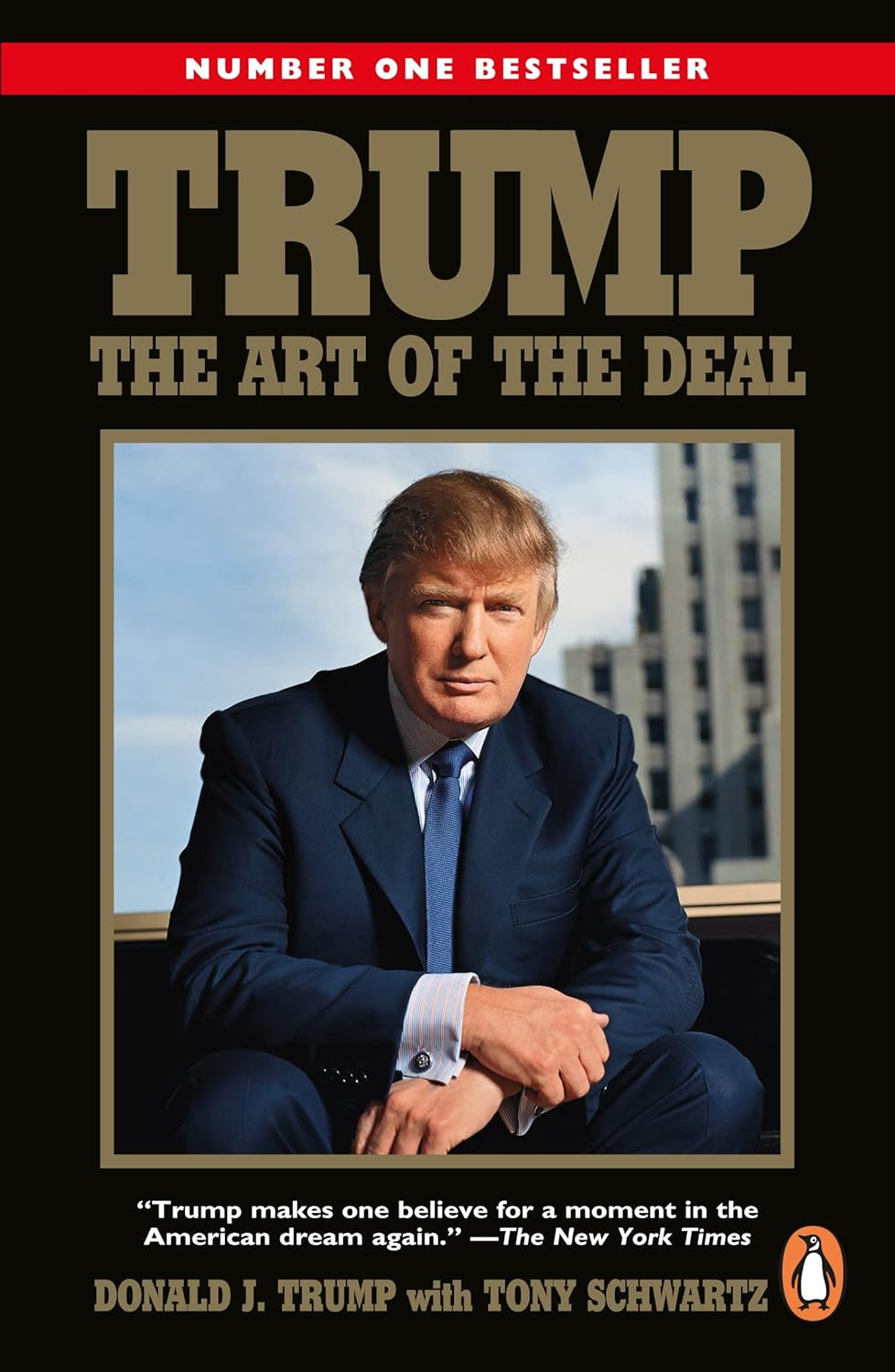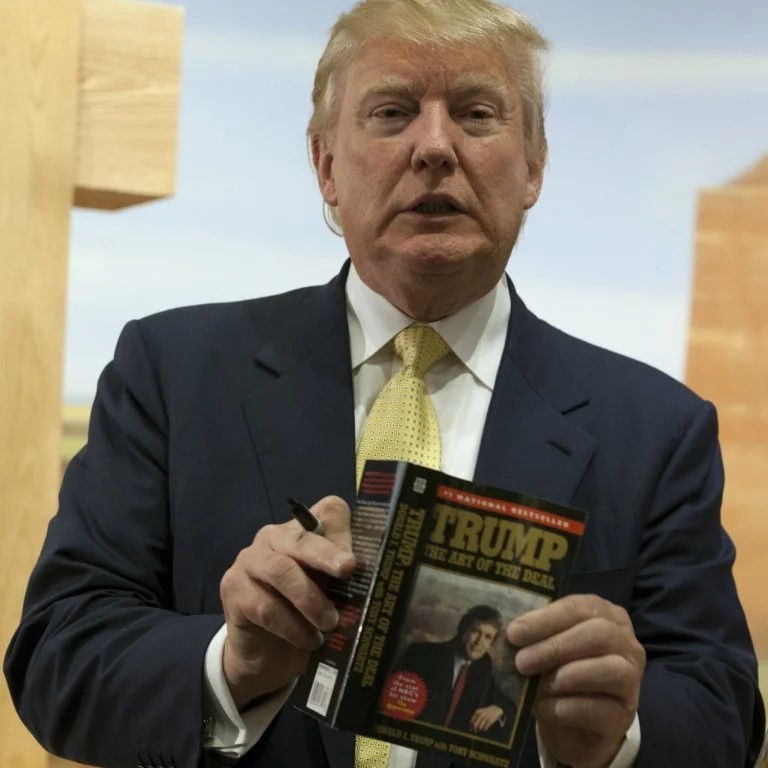
Introduction
Published in 1987, Trump: The Art of the Deal is a part-autobiography, part-business manual written by Donald Trump with journalist Tony Schwartz. The book offers insight into Trump’s business philosophy, his career, and his approach to deal-making. Often considered a self-promotional piece, the book also provides an early glimpse into Donald Trump’s character and thought process, which would later shape his presidency. This review examines the book’s content, themes, strengths, and weaknesses, as well as its impact on business literature and popular culture.
Summary of Donald Trump: The Art of the Deal
The book is divided into two main sections. The first section, covering the first chapter, details a week in Trump’s life, showcasing his routine, meetings, and interactions with business and political figures. The second section focuses on Donald Trump’s background, his major real estate deals, and his overall business strategy.
Donald Trump describes his upbringing in Queens, New York, under the influence of his father, Fred Trump, a successful real estate developer. He explains how he transitioned from working with his father in the outer boroughs to making a name for himself in Manhattan. The book highlights some of his most notable real estate ventures, including the renovation of the Commodore Hotel, the development of Trump Tower, and the Atlantic City casino projects.
At its core, The Art of the Deal outlines Donald Trump’s principles for successful negotiations and business success. Some of these principles include:
- Think Big: Trump emphasizes the importance of ambition and aiming for large-scale success rather than settling for modest achievements.
- Maximize Your Options: He advises maintaining flexibility in business dealings to capitalize on opportunities as they arise.
- Know Your Market: Understanding trends and recognizing value is essential in real estate and business negotiations.
- Use Leverage: Trump discusses how using financial leverage and strategic alliances can yield better deals.
- Enhance Your Brand: He highlights the importance of personal branding and public relations in business success.
Themes and Analysis
- Self-Promotion and Image Crafting Donald Trump’s book is as much about selling himself as it is about business. He carefully crafts a public persona of a fearless dealmaker, someone who refuses to settle for less. The book’s tone is confident, bordering on boastful, as Trump recounts his successes and strategies.
- The American Dream and Capitalism The book portrays Trump as a quintessential self-made man who embodies the American Dream. He presents himself as someone who took calculated risks, overcame obstacles, and turned struggling properties into profitable enterprises. While this narrative appeals to readers who admire entrepreneurship, critics have pointed out that Trump benefited significantly from his father’s wealth and connections.
- Negotiation and Business Strategy The Art of the Deal provides a case study in aggressive negotiation tactics. Trump advocates for always pushing for the best possible outcome, sometimes using brinkmanship and unpredictability to unsettle opponents. These strategies, while effective in some cases, have been criticized for fostering adversarial relationships.
- Perseverance and Risk-Taking Trump portrays himself as a risk-taker who thrives in high-stakes situations. Whether in real estate, casinos, or media, he argues that calculated risk is necessary for extraordinary success. However, the book largely glosses over failures or miscalculations, creating an overly optimistic portrayal of business ventures.
.

.
Strengths of the Book
- Engaging and Readable The book is written in a conversational, straightforward style that makes it accessible to a wide audience. Donald Trump’s anecdotes about his deals and personal experiences make for an entertaining read.
- Valuable Business Insights While some of his strategies may be controversial, The Art of the Deal offers practical insights into business negotiations, branding, and the importance of persistence. Many of the principles Trump discusses—such as thinking big, leveraging opportunities, and understanding market dynamics—are relevant to aspiring entrepreneurs.
- Cultural and Historical Value As a document of 1980s business culture, the book provides insight into the excesses and ambitions of the era. Trump’s rise to prominence in New York City’s real estate world and his early forays into media and entertainment set the stage for his later career.
Weaknesses of the Book
- Self-Aggrandizement and Exaggeration One of the book’s biggest criticisms is Donald Trump’s tendency to exaggerate his successes and minimize failures. While confidence is a key trait in business, the book often blurs the line between fact and self-promotion. Some of the deals Trump highlights were not as successful as he claims, and later investigations have shown that certain accounts were embellished.
- Lack of Depth in Business Analysis Although Trump provides an overview of his deals, the book lacks detailed financial analysis. Readers looking for in-depth business strategies or case studies may find the content somewhat superficial.
- Limited Discussion of Failures The book largely focuses on Trump’s victories, neglecting his business setbacks. While there are occasional mentions of difficulties, there is little discussion of how he handled failures or what lessons he learned from them. Given that failure is a key part of entrepreneurship, a more balanced perspective would have added credibility to his insights.
- Ghostwriting and Authorship It is widely known that Tony Schwartz played a major role in writing The Art of the Deal. In later years, Schwartz expressed regret over his involvement, stating that he painted a more flattering picture of Trump than was warranted. This raises questions about how much of the book reflects Trump’s actual words versus Schwartz’s editorial decisions.
Impact and Legacy
Trump: The Art of the Deal became a bestseller and helped solidify Donald Trump’s brand as a successful businessman and negotiator. The book’s success contributed to his rise as a media personality and later played a role in shaping his political image. During his presidential campaign and tenure, Trump often referenced the book as proof of his business acumen.
However, in retrospect, the book has also been critiqued for its lack of transparency and its exaggerated claims. While it remains an influential work in business literature, many of its lessons need to be taken with a grain of salt.
Conclusion
Overall, Trump: The Art of the Deal is an engaging, though sometimes self-serving, look into Donald Trump’s business mindset. The book is valuable for those interested in negotiation tactics, branding, and the psychology of high-stakes deal-making. However, it should be read with a critical eye, as it presents an idealized version of Trump’s career and downplays setbacks. Despite its flaws, the book remains a significant work in understanding both Trump’s approach to business and the broader culture of success in 1980s America.
Check out Donald Trump on Amazon by clicking here.
Check out Trump: The Art of the Deal on Amazon by clicking here.
If you found this review useful please share it with friends and family and then check out some of our other Book Reviews.
.
